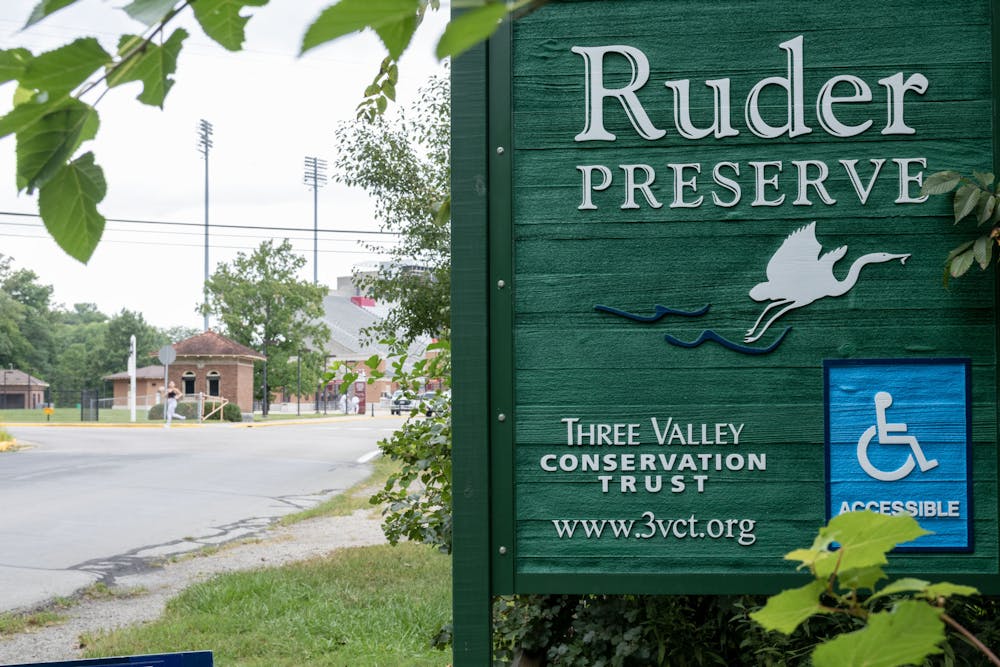Southwest Ohio is a region rich in fertile agricultural land fed by dozens of streams that crisscross the landscape, with pockets of protected forest and grassland reminiscent of pre-settlement ecosystems dotting the map. Behind hundreds of plots and thousands of protected acres is the Three Valley Conservation Trust, a non-profit with deep ties to the Oxford community.
Founded as a trust in 1993 to “preserve open land in the Four Mile Creek Valley in southwest Ohio,” Three Valley now owns or helps to preserve more than 24,000 acres of land in Southwest Ohio. The trust has also assisted private landowners in receiving nearly $40 million in state and federal funding through easements.
“We want to make sure that the ecosystem services on that property and the habitat on that property remain at least as good as they are when we get it or get better,” said Randy Evans, the executive director of Three Valley Conservation Trust.
Three Valley undertakes a wide range of conservation projects, including water quality monitoring, native habitat restoration and property management. Through easements, they have allowed hundreds of property owners to transform their land into more functional and healthy ecosystems.
“It's our way of making sure that water quality increases, air quality increases in the area [and] biodiversity increases in the area,” Evans said.
The trust operates in multiple counties in Southwest Ohio, and Butler County is one of the biggest in terms of properties managed and partners worked with. This has led to deep ties between Three Valley and the Oxford community.
Evans said some of the trust’s partners include the Miami Valley Audobon Society, Project Dragonfly and the Oxford Community Foundation, its largest donor. These connections extend to Miami University, and even beyond student volunteers.
“All of our full-time employees at Three Valley started as interns from Miami University,” said Evans, who started as a GIS intern in 2014.
Along with its employees, the board of Three Valley has two active Miami professors, two retired professors and multiple other Oxford residents. One of those is Amy Sullivan, an assistant professor who helps run the graduate program Project Dragonfly.
“I volunteered to be part of the outreach and education committee and also join the board,” Sullivan said. “Currently I’m the secretary taking minutes for all of the board meetings.”
Sullivan has been encouraged with the restoration of wetlands on private and public properties around Oxford. She is especially glad to see that the property closest to the university, Ruder Preserve, has improved as well.
Ruder Preserve is a 160-acre wooded property off of Bonham Rd. just south of Yager Stadium. It is a popular spot because of its connection to the Miami Natural Areas and accessibility.
Enjoy what you're reading?
Signup for our newsletter
“We had some wonderful community members who provided donations to put in a parking lot and start building a boardwalk,” said Evans. “Our goal there was to make that parking lot and boardwalk too accessible for everybody in the community.”
As one of the few properties that the trust fully owns, the team is constantly working to maintain and preserve the rich biodiversity of this plot. This includes both planting native species and removing invasive ones.
“If you went to Ruder just a few years ago, you would have seen an area that was very different from what’s there now,” Sullivan said. “It was fully overrun with honeysuckle, and it’s primarily student groups which have cleared that out.”
One of those student groups volunteering in Ruder is the Miami Naval ROTC. After being referred to Donna McCollum, the trust’s volunteer coordinator, students in the Naval ROTC assisted in invasive species removal in the preserve.
“We went in with chainsaws, cut everything down, pulled it out, made large piles, and then we went and applied herbicides to the stumps,” said Michael Halter, a sophomore diplomacy & global politics major. “We would go through and clear everything out dragging [it] into specified big piles. We [had] like three huge 10-foot piles.”
Halter volunteered multiple times throughout the last school year removing the invasive bush amur honeysuckle, and other Naval ROTC students helped to manage different invasive species. Collin Quinn, a junior political science major, and Shawn Baer, a junior Russian, East European and Eurasian studies major, also helped Three Valley with the removal of garlic mustard, an invasive weed.
“I think a lot of students overestimate how hard it would be to get started volunteering in the community,” Baer said. “It took midshipman Quinn and I a small, small portion of our Sunday and got us outside being active, and … we get to meet some cool people and have some really interesting experiences.”Along with funding from donors such as the Oxford Community Foundation, Three Valley heavily relies on volunteers to help maintain and restore their properties. Evans said more than 200 volunteers helped out in Ruder Preserve alone in 2022.
“The work that we do helps preserve the visual viewshed, the character of this area,” Sullivan said. “But also it is super important for water quality, for conserving and improving that, soil quality, for maintaining our ability to continue to produce food on these lands, and of course biodiversity.”
Individuals or groups interested in volunteering can visit the trust’s website for more information.




